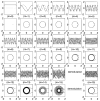An analytical SMASH procedure (ASP) for sensitivity-encoded MRI
- PMID: 10800037
- PMCID: PMC1941706
- DOI: 10.1002/(sici)1522-2594(200005)43:5<716::aid-mrm14>3.0.co;2-k
An analytical SMASH procedure (ASP) for sensitivity-encoded MRI
Abstract
The simultaneous acquisition of spatial harmonics (SMASH) method of imaging with detector arrays can reduce the number of phase-encoding steps, and MRI scan time several-fold. The original approach utilized numerical gradient-descent fitting with the coil sensitivity profiles to create a set of composite spatial harmonics to replace the phase-encoding steps. Here, an analytical approach for generating the harmonics is presented. A transform is derived to project the harmonics onto a set of sensitivity profiles. A sequence of Fourier, Hilbert, and inverse Fourier transform is then applied to analytically eliminate spatially dependent phase errors from the different coils while fully preserving the spatial-encoding. By combining the transform and phase correction, the original numerical image reconstruction method can be replaced by an analytical SMASH procedure (ASP). The approach also allows simulation of SMASH imaging, revealing a criterion for the ratio of the detector sensitivity profile width to the detector spacing that produces optimal harmonic generation. When detector geometry is suboptimal, a group of quasi-harmonics arises, which can be corrected and restored to pure harmonics. The simulation also reveals high-order harmonic modulation effects, and a demodulation procedure is presented that enables application of ASP to a large numbers of detectors. The method is demonstrated on a phantom and humans using a standard 4-channel phased-array MRI system.
Copyright 2000 Wiley-Liss, Inc.
Figures








References
-
- Roemer PB, Edelstein WA, Hayes CE, Souza SP, Mueller OM. The NMR phased array. Magn Reson Med. 1990;16:192–225. - PubMed
-
- Wright SM, Magin RI, Kelton JR. Arrays of mutually coupled receiver coils: theory and application. Magn Reson Med. 1991;17:252–268. - PubMed
-
- Bottomley PA, Olivieri CHL, Giaquinto R. What is the optimum phased array coil design for cardiac and torso magnetic resonance? Magn Reson Med. 1997;37:591–599. - PubMed
-
- Hutchinson M, Raff U. Fast MRI data acquisition using multiple detectors. Magn Reson Med. 1988;6:87–91. - PubMed
-
- Kwiat D, Einav S, Navon F. A decoupled coil detector array for fast image acquisition in magnetic resonance imaging. Med Phys. 1991;18:251–265. - PubMed
Publication types
MeSH terms
Grants and funding
LinkOut - more resources
Full Text Sources
Other Literature Sources
Medical

